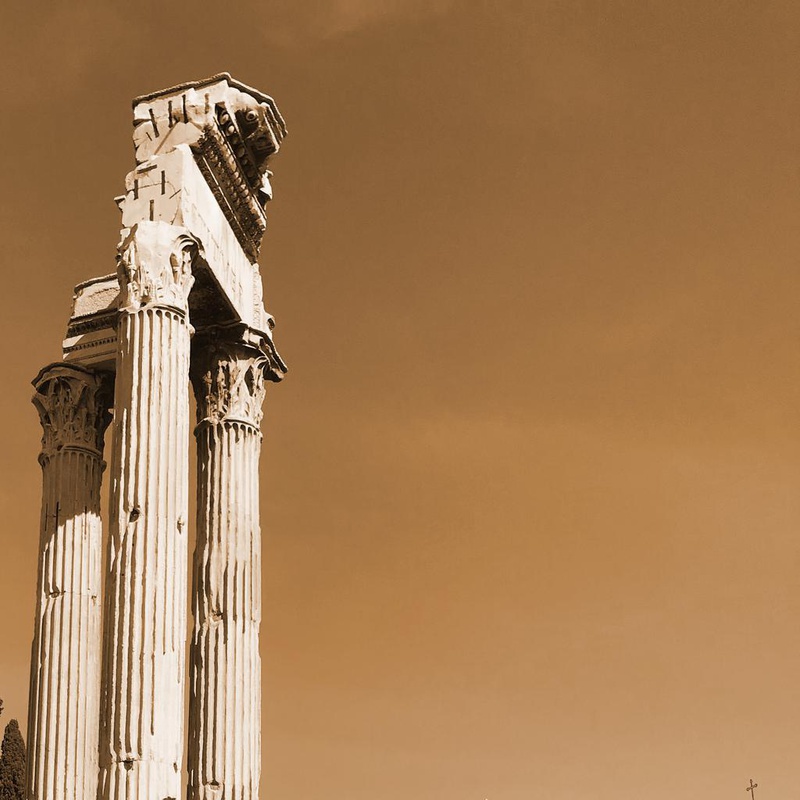Posted by Shazarch on 18 Mar 2021
Temple of Vespasian and Titus
1st century CE, Roman Forum
Religious site / Temple
The temple dedicated to the Emperor Vespasian, begun by his son Titus during the brief period of his empire and completed by his brother and successor, Domitian, is situated in the northwest part of the Forum at the base of the Capitoline hill, next to the Tabularium, between the Temple of Concord and the Portico of the Harmonious Gods, in a small but essential space. Vespasian was the initiator of the gens Flavia or Flavians. He was the emperor who after the death of Nero, the civil war and the rapid succession of three emperors (Galba, Otho and Vitellius), ensured a return to order and normality, and the centrality of an internally pacified Rome in the empire. He is a new man, a soldier of modest origins, not a member of the senatorial aristocracy, and with respect to the emperors of the Julio-Claudian dynasty, cannot boast any illustrious or mythical ancestors like Julius Caesar or Enea. His image is one of simplicity, probity and parsimony, as described by Suetonius. However, after his death in 79 AD, his deification marked the beginning of an exaltation of the dynasty, begun by Titus and pursued with force by Domitian during his reign (81-96 AD). A temple to the deified Vespasian was therefore built inside the Roman Forum, purposely in relation to the temple that Augustus dedicated to Caesar on the site of his cremation. The Temple of Vespasian is "an almost perfect complement, at least as far as the pre-existing Temple of Concord permitted, to the Temple of the deified Julius Caesar: the founders of these two successive dynasties faced each other in the Forum in a demonstration of family majesty" (M. Torelli). The symmetry of the Flavian and Julian families underlines the legitimacy of the passage of power from the Julio-Claudians to the Flavians, who like the former ensured Rome's order and splendour. And if Caesar, Augustus and Claudius were forerunners in deification and imperial worship, these practices become more dynastic with Domitian, who took up the task of deifying his brother Titus, celebrating the Flavians not only in the Temple of Vespasian but also in other buildings, such as the Divorum in Campo Marzio and the Templum Gentis Flaviae on the Quirinal hill, and in a broader building programme that included different parts of the city. The Temple of Vespasian, according to late sources, dedicated also to Titus, is one of the building projects that Domitian inherited from his brother, if not from his father. Its completion before 87 AD was an expression of political continuity. It is part of the broader system of work undertaken by Domitian in the Roman Forum: from the Portico of the Harmonious Gods, for example, to the great equestrian statue of Domitian in the centre of the square, between the temples of Caesar and Vespasian, that redefines the visual and symbolic relationships between pre-existing buildings by placing the figure of the new ruler between the two. Toda's remains tell the story of a smallish but sumptuous temple. The still visible outline of the foundations indicates its area. What remains of the podium and the three Corinthian columns, 15 metres high, at the northern corner of the pronaos, suggest a hexastyle temple, with six columns on the facade and two laterally. The capitals and lateral frieze, that shows ritual objects, indicator fine decoration and quality craftsmanship. According to a 9th century transcription, the fragments of inscriptions on the existing part of the architrave show that the temple was dedicated to Vespasian and indicate subsequent restorations, presumably minor, during the empires of Septimius Severus and Caracalla. The cella or naos, which extends to the outer walls to allow the greatest possible area, the front steps leading up to the colonnade, and the blind wall abutting the Tabularium, in which the gate into the Forum had to be closed, are just some signs of exploitation of a limited space for a temple that had to be erected in this densely built up part of the Forum, on the slopes of the Capitoline hill and at the foot of the Temple of Jupiter, first rebuilt by Vespasian and then by his sons.
